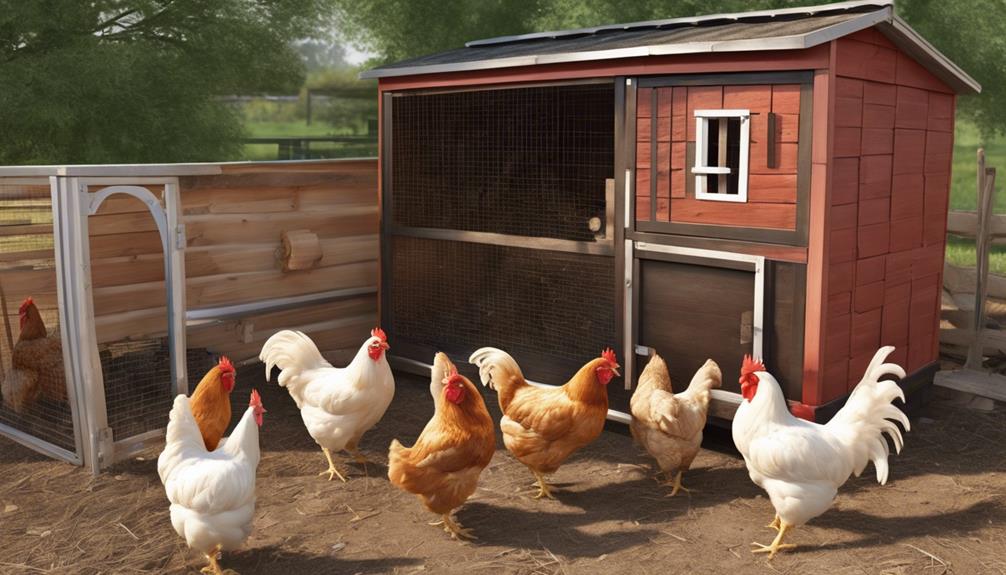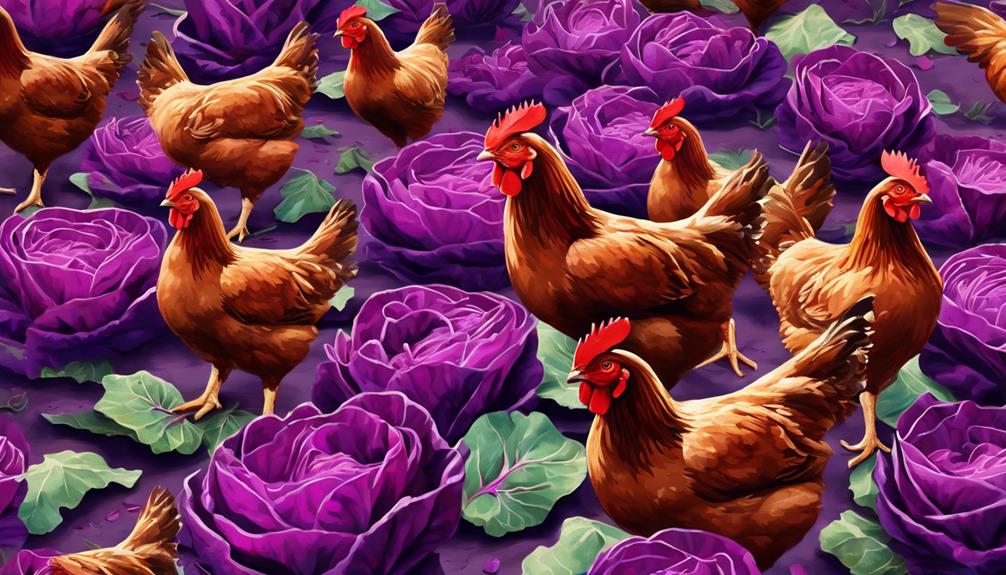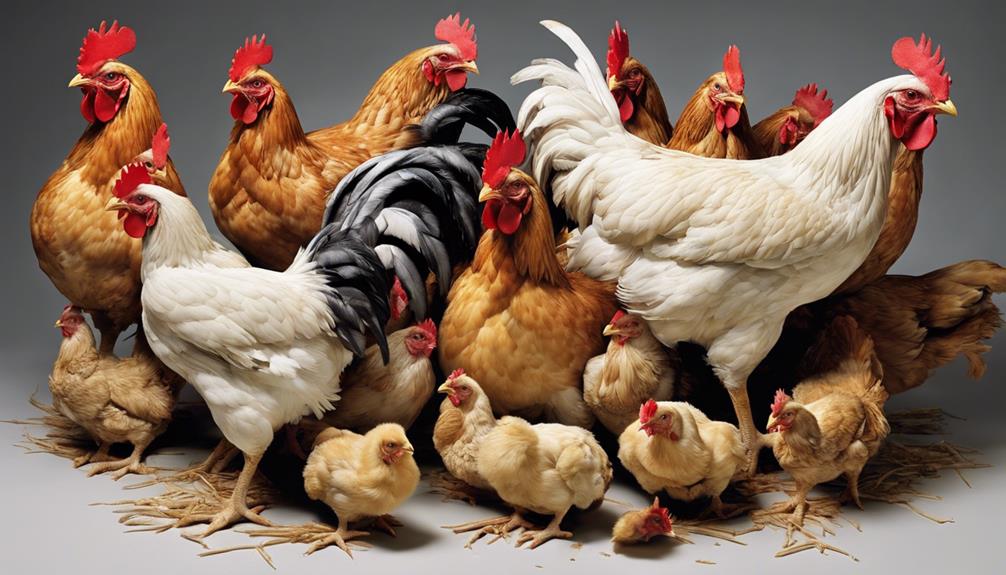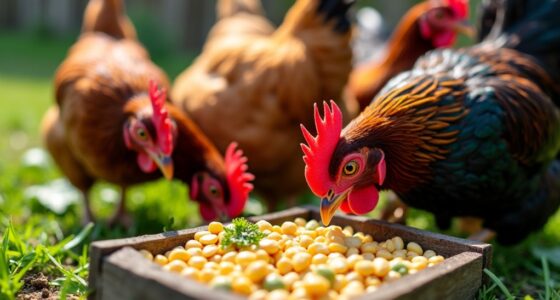Chickens have an interesting method of eliminating waste by combining uric acid with feces and expelling it through their cloaca. This efficient waste management system allows them to get rid of both liquid and solid waste at the same time.
Understanding this unique excretory mechanism can provide valuable insights into avian health and behavior.
Key Takeaways
- Chickens excrete uric acid and feces through the cloaca.
- Uric acid appears as white crystals in droppings.
- Lack of a bladder streamlines waste elimination process.
- Proper hydration and diet are crucial for urinary health.
- Understanding avian anatomy aids in overall health comprehension.
Chicken Urination Process Explained
In chickens, the process of urination differs significantly from mammals, as they excrete uric acid combined with feces through their cloaca. Unlike mammals that produce urine as a liquid waste, chickens convert nitrogenous waste into uric acid, a white crystalline substance. This unique feature in the chicken urinary system serves a dual purpose by eliminating both solid and liquid waste simultaneously.
The cloaca acts as a multi-functional opening in chickens, allowing the passage of both feces and uric acid out of the body. This combined excretory process aids in conserving water, crucial for birds living in arid environments. However, this system requires chickens to maintain proper hydration levels and a balanced diet to prevent health issues related to their urinary system.
Understanding the intricacies of the chicken's excretory system is vital for ensuring their well-being. By recognizing the significance of uric acid excretion and the role of the cloaca in the chicken urinary process, owners can implement proper care practices to support optimal urinary health in their feathered companions.
Anatomy of Chicken Excretory System

The anatomy of the chicken excretory system reveals a unique adaptation to efficiently eliminate waste products without the presence of a bladder. Chickens excrete a combination of feces and liquid urine as droppings due to the lack of a bladder in their digestive system. This integrated excretion process allows for the simultaneous removal of waste products, ensuring efficient waste elimination without the need for a separate urinary storage organ.
The absence of a bladder in chickens doesn't hinder their excretory function; instead, it streamlines the excretion process, making it a normal and effective mechanism for these avian species. The combination of feces and liquid urine in chicken waste plays a vital role in maintaining their urinary health.
The unique texture of white crystals seen in chicken droppings is attributed to the presence of uric acid, a characteristic feature of avian excretion. Understanding the intricate anatomy of the chicken excretory system is essential for comprehending the physiology behind their excretory process and overall health.
Understanding Avian Uric Acid Formation
Avian uric acid formation results from the metabolic processing of proteins in chickens, leading to the production of white crystals in their excreted waste. When chickens consume proteins, their bodies break them down into amino acids. These amino acids are then metabolized and converted into various by-products, one of which is uric acid.
In the avian system, uric acid isn't dissolved in water like urea, which is found in the urine of mammals. Instead, it combines with other waste materials in the cloaca to form a white paste that's excreted along with solid waste.
The lack of a urinary bladder in chickens means that all waste, including uric acid, is expelled through the cloaca. This unique excretion process allows chickens to efficiently eliminate nitrogenous waste while conserving water. The white crystals seen in chicken droppings are primarily composed of uric acid and serve as a concentrated nitrogen source, beneficial for fertilizing plants.
Understanding avian uric acid formation provides insights into the efficient waste management system of chickens.
Frequency of Chicken Waste Elimination

Understanding the frequency at which chickens eliminate waste sheds light on the efficiency of their excretory system and the volume of droppings produced daily. Adult chickens exhibit high levels of waste elimination, with each chicken expelling waste, including urine and feces, approximately every 30-90 minutes.
This frequent elimination results in a substantial amount of chicken manure being generated daily. For a single chicken, this can range from 15-48 droppings per day, and when considering a group of 10 chickens, the daily output can reach 150-480 droppings. This significant production of waste necessitates the need to know how to manage chicken manure effectively, especially for those utilizing it for fertilizing garden beds.
Due to the regularity and volume of droppings produced, consistent waste management practices are crucial to maintain a healthy environment for the chickens and to ensure the proper disposal or utilization of the generated manure.
Managing Chicken Manure Effectively

How can we maximize the benefits of chicken manure in agricultural practices while minimizing environmental impacts?
When it comes to managing chicken manure effectively, there are key strategies to consider:
- Utilize chicken manure as a soil amendment: Incorporating chicken manure into the soil can enhance its quality by improving water retention and increasing nutrient content.
- Compost chicken manure: Composting not only reduces the volume of manure but also helps in killing pathogens, transforming it into a more potent fertilizer for plants.
- Leverage the nutrient content: Chicken manure is rich in essential nutrients like potassium, nitrogen, and phosphorus, which are beneficial for both plants and soil health.
- Apply aged chicken manure appropriately: Using aged chicken manure, especially when not close to harvest time, ensures safe and effective utilization in gardening without risking contamination.
Frequently Asked Questions
What Is the Excretory System of a Chicken?
The excretory system of a chicken is unique among animals. Chickens lack a bladder, so they excrete a combination of urine and feces as droppings. Uric acid in their waste forms white crystals, granting their droppings a distinctive appearance.
Despite the absence of a bladder, chickens efficiently eliminate waste without hindrance. Understanding this system is crucial for maintaining their urinary health and overall well-being.
What Is the Urinary System of a Chicken?
We've delved into the intricate urinary system of chickens, discovering their unique adaptation without a bladder. This system efficiently combines uric acid with feces for excretion through the cloaca.
The absence of a bladder is a remarkable feature, showcasing the evolutionary prowess of these birds. Understanding this aspect is crucial for effective urinary health management in chickens.
Their excretion process, though different from mammals, is a testament to their biological efficiency.
What Is the Urinary System of the Avian?
We excrete uric acid combined with feces through the cloaca as birds. This unique system allows for efficient waste removal. Birds lack a bladder, and urine and feces are expelled together.
Uric acid crystals contribute to the white appearance of bird droppings. Understanding avian excretion is vital for proper husbandry and health maintenance. Adequate hydration and diet play crucial roles in ensuring optimal urinary function for birds.
What Is the Process of Excretion in Birds?
Excretion in birds involves the cloaca, a multifunctional opening for waste elimination.
Uric acid, a product of protein metabolism, is excreted along with solid waste.
Birds lack a separate bladder, excreting waste efficiently to maintain fluid balance.
This unique system showcases avian adaptation.
How Can Understanding Avian Excretion Help in Keeping Chickens Out of Your Yard?
Understanding avian excretion is crucial for a comprehensive guide keeping chickens out of your yard. By learning about their excretion habits, you can take appropriate measures to discourage chickens from congregating in your yard, such as cleaning up droppings promptly and using barriers to prevent access.
Conclusion
In conclusion, understanding how chickens pee is vital for proper waste management in poultry farming. Just like a well-oiled machine, the avian excretory system efficiently eliminates waste through uric acid formation.
By managing chicken manure effectively, farmers can maintain a clean and healthy environment for their flock.
Remember, a well-maintained waste disposal system is like a breath of fresh air in the poultry industry.










